|
|
|
|
China's Transition, by Andrew J. Nathan
written with Tianjian Shi
Chinese political culture is often cited as an obstacle to the realization of democratic aspirations. 1 Its undemocratic attributes are generally thought to include authoritarianism, passivity, ignorance of politics, fear of politics, and intolerance. The first national sample survey of Chinese political culture allows a more nuanced look at some related attributes and their distribution among the population. Some of the specific findings are surprising, and the overall pattern suggests that political culture may affect democratization in more complex ways than usually acknowledged.
Until now, evidence concerning the nature of Chinese political culture has been drawn from interpretive studies. 2 We use this term to describe studies that are characteristically based on documentary sources, interviews, and field observation. Interpretive studies seek to identify complex sets of attitudes, or syndromes, of values, beliefs, and practices, which are thought to be distinctive of, or even unique to, a given culture, or to a broad section of its population, often over a long span of time. 3
When implemented well, the interpretive approach to the study of political culture has marked strengths. These include the ability to characterize the culture of a whole people or of large social segments; the ability to attend both to broad themes in a culture and to nuance, contradiction, levels of meanings, and dialectical relationships; and the capability to use documents and other historical evidence to retrieve information about the belief and value systems of the past.
The approach also has weaknesses. These include a tendency to imprecision when specifying referents (what the belief or attitude in question consists of); frequent ambiguity of propositions (who is said to have believed what at what time, and with what effect); an inability to provide rigorous, intersubjectively reliable evidence that the propositions are more true than alternative propositions (are the Chinese really more authoritarian than some other people?); a tendency to tautological arguments about the effects of culture on behavior, since behavior itself is often used as an indicator for the existence of a belief or attitude; the inability to describe with precision the distribution of attitudes among the population; and the inability to carry out analytical procedures to distinguish the effects of sociodemographic attributes on cultural attitudes or the effects of attitudes on behavior. In short, even the best interpretive work consists of broadly stated, loosely specified insights using ill-defined terms, meaning different things to different readers, and making statements that may or may not be true.
These weaknesses multiply when a cross-cultural comparison is attempted. For example, Chinese are said to be more collectively oriented, Americans more individualistic. But interpretive studies cannot give precise or reliable answers as to what this means, how large the difference is, whether the contrast really exists, and how different sectors of the two populations vary among themselves.
An alternative to the interpretive approach, the survey approach, has been widely applied to the study of democratic political systems, but has not been used very much in the study of Chinese culture. 4 Its research tool is the sample survey, whose use requires precise sampling methods, sophisticated interviewing techniques to assure reliability, scoring and scaling techniques to sort and organize responses in categories related to theoretical variables, and statistical analysis and inference. 5 In this approach, political culture is conceptualized as the distribution of values, attitudes, and beliefs toward politics among a population. 6 The unit of observation is the individual. Culture is an aggregative concept referring to the pattern of attitudes among the population or a specified subset.
When implemented well, the survey approach has certain advantages. These include clear specification of referents, disambiguation of propositions, empirical reliability of findings, the ability to measure variation in cultural attributes among a population, the potential ability to measure change over time if serial surveys are done, avoidance of tautology in the specification of relations between culture and behavior, and the ability to perform a wide range of statistical analyses, including analyses of the effects of sociodemographic variables on culture, and of cultural variables on political behavior.
The method also has disadvantages. Aside from its technical difficulty, these include the inability to go back in time except under special circumstances, the technique's flattening or simplifying effect on the cultural attributes which can be measured, and the intrinsic inability to identify attributes which are or might be culturally unique, except in a trivial sense. We discuss these advantages and problems later.
Prior to the study reported here, no one had done a survey of Chinese political culture that was based on a random sample and hence permitted statistical induction. 7 A few studies by foreign scholars employed multiple émigré interviews, but the numbers of respondents were too small and the samples too unrepresentative to make induction possible. 8 In the 1980s, scholars in China began to conduct surveys, some of which touched on political-cultural topics. According to Dong Li, during the period from 1979 to 1991, Chinese scholars conducted at least 181 surveys concerning political attitudes. 9 Only one was national in scope, Min Qi's Chinese Political Culture , carried out in 1987 under the auspices of the Beijing Social and Economic Research Institute. 10 All the Chinese surveys on which we have information, including Min Qi's, were methodologically flawed in terms of sampling, question formulation, and interview techniques. Min Qi's study, for example, severely undersampled women, older citizens, rural residents, and other key sectors of the population.
This chapter reports some results from a survey conducted in China in 1990 which is, so far as we know, not only the first scientifically valid national sample survey done in China on political behavior and attitudes, but also the first valid national-level sample survey on the political behavior and attitudes of the general populace ever done in a communist country. 11 (See the Appendix to chapter 12 for details.)
The survey assessed approximately fifty political-cultural variables, too many to examine in a single essay. As a first step, we have selected for discussion certain items which involve the cultural requisites for democracy, and which were designed to permit cross-national comparison. Most of them were adapted from two classic studies--Gabriel Almond and Sidney Verba's The Civic Culture and the International Social Survey Program (ISSP). 12 We are comparing China in 1990 to other countries in 1959-1960 and 1985 respectively, and to countries that were democratic at the time of their surveys. 13 These time gaps and system differences present no obstacle to comparison as long as we take account of them in the analysis.
The study of political culture emerged from curiosity about the prerequisites for stable democracy, especially the relationships between citizens' subjective orientations and democratic stability. Theorists have stressed the importance to the democratic process of such values as the belief in popular sovereignty, commitment to the equality of citizens, and the principle of majoritarian decisionmaking with adequate protection of minority rights. 14 In a recent study of Russian political culture, James Gibson and Raymond Duch identified five values conducive to democracy: (1) the belief in the legitimacy of democratic institutions; (2) beliefs about authority relationships between government and the governed; (3) confidence in the capacity of the government; (4) political and interpersonal trust; and (5) the belief in the possibility of cooperation and the legitimacy of conflict. 15
We focus here on three dimensions of political culture which we believe are fundamental to democracy: First, do citizens perceive the government as salient to their lives, as having an impact on themselves and their families? Second, do people believe that they have the capability to understand and engage in politics? Third, to what extent are citizens prepared to be tolerant of those who hold different political beliefs?
We show that while some of the attitudes associated with democracy are less prevalent in China than in some other countries, Chinese political culture is neither especially traditional nor especially totalitarian. Our findings lead to two kinds of concluding reflections: on the prospects for democracy in China and on cultural distinctiveness--not only China's cultural distinctiveness, but the notion of cultural distinctiveness as it appears from the perspective of the survey approach to culture.
The Perceived Impact of Government
One of the cultural requisites commonly cited for democracy is that citizens perceive the actions of government to be salient to their lives. An awareness of the impact of government is thought to generate interest in politics and a desire to participate in the political process. The classic question to assess this attitude was asked by Gabriel Almond and Sidney Verba, authors of The Civic Culture , who separately measured citizens' perceptions of national and local government impact. We asked the same two questions in China. 16 Our results are displayed with Almond and Verba's in Table 1 and 2.
It is striking that so few Chinese citizens perceive their government as having an impact on their daily lives. Whether China's system is now or ever was totalitarian is a subject of debate, 17 but few would question that the Chinese government is more intrusive in citizens' lives and deals with a
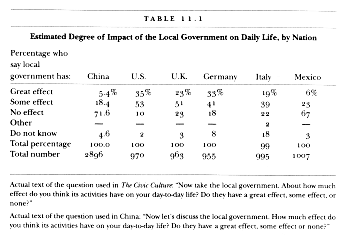
broader scope of policy than most other governments. Yet, approximately 72 percent of Chinese citizens stated that both national and local governments had no effect on their daily lives, figures comparable in the Almond and Verba data only to Mexico. As in most of the other nations, slightly more Chinese attributed the influence to local rather than to the national government, but the difference was not great.


Do differences in the structure of public administration in China help explain the low salience of national and local governments? Unlike the five nations referred to in The Civic Culture , the structure of government in China extends below the local (provincial and county) levels to the urban neighborhood and rural village committees, the so-called "grass-roots level of government," and below these to the work units which are officially nongovernmental. 18 Even if Chinese citizens are unaware of the impact of the national and local government, they may perceive the impact of the village/neighborhood level of administration, which performs many distributive and redistributive functions important to local residents. Figure 11.1 reveals that, indeed, a higher percentage of respondents perceive an effect on their lives from the village/neighborhood level of administration than from the national or local levels. But the numbers are still remarkably low.
It is also possible that the low Chinese totals result from different groups of citizens paying attention to the impact of different levels of government, each focusing on the level that most concerns him or her. If a different group of citizens were aware of the impact of each level of the government, then the groups added together would make for a widespread awareness of government at one level or another. However, Figure 11.2 shows that this is not the case. Nearly 60 percent of the population attributes no impact to any of the three levels of government.
In any society, awareness of the government is likely to vary with such individual attributes as urban residence and education. If the population is heavily weighted toward persons who are less likely to be aware of the impact of government, the overall level of awareness might be low in

the population as a whole because of the population's composition rather than because of the nature of the culture. Modernization theory suggests that urban Chinese might be more aware of the impact of government on their lives than rural residents. According to this theory, economic development expands the proportion of higher status roles in a society, involves tensions and strains among social groups, produces an expansion of the functions of the government, and raises the saliency of an individual's identity as a member of the national state. These trends usually lead to higher levels of political mobilization. 19 Since urban China is more developed than rural China, urban residents might be more aware of the impact of government than their rural cousins.
When we subdivided our sample into urban and rural sectors as shown in Figure 11.1, we found that, as expected, more urban than rural residents attributed some influence to the national and local governments. 20 But the urbanites did so at levels below all the Civic Culture nations except Mexico. Unlike rural residents, urban residents perceived no substantial difference in the influence of the three levels of the administration.
In the Civic Culture nations, awareness of the government's impact varied with educational level. Italians and Mexicans without formal education had a very low level of awareness of the impact of the national and local governments. 21 In China, 25.7 percent of our sample was illiterate and another 30 percent had educations at or below the primary level. 22 This suggests that the differing aggregate levels of awareness among
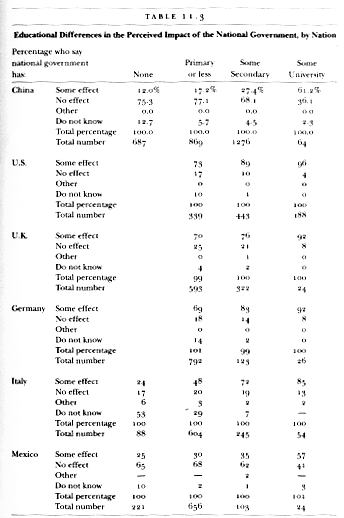
the six countries might be due to differences in the educational makeup of national populations. Table 11.3 shows that in China, as elsewhere, the perceived impact of the national government varies substantially with the level of education, with less-educated respondents less likely to perceive an impact by the government on their daily lives. In both China and Mexico, the high proportion of less-educated citizens in the total population partly explains why the aggregate estimate of the impact of the government is low.
But the data also reveal that at each educational level, Chinese respondents are less aware of the impact of the government than similarly educated respondents in the other five nations. About half as many Chinese with no formal education perceive the national government to have an impact as do uneducated Italians and Mexicans. For those with primary educations, the gap was 55.8 percent between Chinese and Americans, 52.8 percent between Chinese and Britons, 51.8 percent between Chinese and Germans, 30.8 percent between Chinese and Italians, and 12.8 percent between Chinese and Mexicans. Even among persons with university educations, the Chinese are substantially less likely to perceive a national government impact, with gaps ranging from 20 to over 30 percent. The sole exception is Mexico: Chinese with university educations are slightly more likely than similarly educated Mexicans to perceive an impact of the national government on their daily lives.
The initial impression remains unshaken: compared to citizens in the five democratic nations studied in 1959-1960 in The Civic Culture , Chinese citizens in 1990 were relatively unaware of the impact of the government on their daily lives even when education is held constant. But the Chinese profile did not depart far from that of the Mexicans thirty years earlier, when Mexico was already considered a democracy, although not yet a highly developed one. In Almond and Verba's terms, Chinese citizens today are still relatively parochial; 23 the workings of even the grass-roots levels of administration remain obscure to the majority.
According to conventional wisdom, the state in communist systems exercises close control over society. Our data are not about the objective role of the state, but about the subjective perceptions of ordinary citizens. We seem to have found a gap between the two. Although the regime in China controls the daily lives of citizens more totally than was the case in the five nations studied by Almond and Verba, fewer citizens are able to identify such control. We do not know what mechanisms are at work to produce this paradox--whether the regime manages to make its subjects overlook its control over their daily lives or whether the citizens contrive to ignore the regime's control as a way of managing the psychological tension that it induces. In any case, the finding suggests that the Chinese regime enjoys a "safety cushion" of popular underestimation of its role, which may to some extent blunt demands for democracy.
Political Efficacy
The sense of efficacy is a powerful determinant of people's involvement in politics. Whether or not citizens can influence politics, their beliefs about whether they can do so help guide their political behavior. Feelings of efficacy motivate people to engage in political activities, while the absence of these feelings evokes political apathy and withdrawal. Some researchers consider efficacy a key indicator of the health of a democratic system. 24
Political efficacy was originally defined as "the feeling that individual political action does have, or can have, an impact upon the political process." 25 Two different operationalizations of the concept have been popular in the literature. Almond and Verba concentrated on whether citizens believe that they have the capacity to wield influence. They differentiated political efficacy into subject and citizen "competence." The former refers to a person's awareness of his or her rights to fair and equal treatment from the government, the latter to his or her awareness of the ability to influence the government. 26 The approach associated with the Survey Research Center (SRC) of the University of Michigan puts more emphasis on the perceived responsiveness of political institutions than on the respondent's sense of his or her own capabilities. 27
Subsequent research demonstrated that both approaches are valid. Political efficacy is a multidimensional phenomenon containing two separate components. One is internal efficacy, which consists of beliefs about one's competence to understand and participate in politics. The other is external efficacy, which refers to beliefs about the responsiveness of the government. 28 Internal efficacy in turn contains two subdimensions: the belief in one's ability to understand complicated political issues and the belief in one's ability to act politically. The former component affects the likelihood that people engage in politics; the latter affects the level and patterns of participation.
Some measures of internal efficacy in China are displayed in Table 11.4. The table shows that slightly less than half (47.3 percent) of our respondents deemed themselves able to understand work unit issues as well as other people. In relation to the national government, the percentage of persons with a sense of efficacy dropped to 31.9 percent. 29
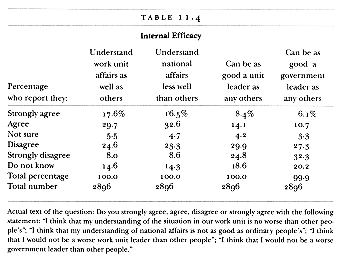
About 20 percent of the population believed that they could be as good a leader in their work unit or village as others, and 16.8 percent had confidence in their ability to serve as government leaders.
Table 11.5 shows the results from a similar but different question, which asks the respondent to rate his or her understanding of the issues facing the nation, the local government, and the unit. Self-rated understanding
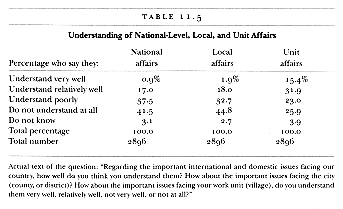
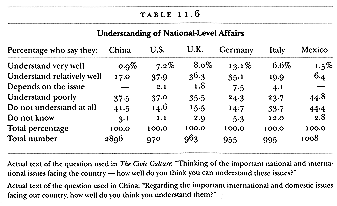
of unit affairs is again higher than self-rated understanding of local or national-level affairs. Nearly 50 percent of the respondents felt that they understood the "important issues facing [their] work unit" very well or relatively well, compared to 19.9 percent for local issues and 17.9 percent for national-level issues. Taken together, the figures from Tables 11.4 and 11.5 demonstrate a substantial gap in internal efficacy when one moves from the grassroots level of administration to formal government institutions.
Tables 11.6 and 11.7 place these Chinese figures in the context of comparable figures from The Civic Culture . Chinese citizens generally scored lower on this measure than citizens of other nations, but they did not lag
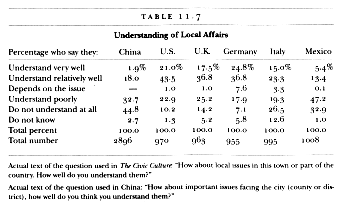
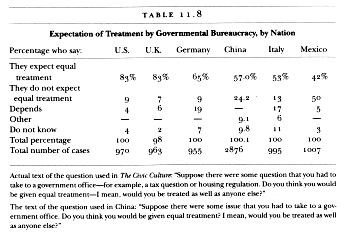
behind the Italians and the Mexicans in all respects. Although fewer Chinese than Italians or Mexicans claimed to understand either national-level or local issues "very well," the sum percentage of Chinese understanding national-level issues "relatively well," "depends," and "poorly" was higher than in Italy and Mexico, and the percentage claiming to understand national-level affairs "not at all" was lower than in Mexico.
Turning to external efficacy, the best-established measures would have been too sensitive to ask in China. 30 As a surrogate, we used Almond and Verba's measure of "output affect," which, besides feasibility, offered the opportunity for further comparison with the Civic Culture countries. The question asks about the respondent's expectation of equal treatment at a government office. In view of China's reputation for government corruption and abuse, it comes as a surprise to find in Table 11.8 that Chinese citizens in 1990 were not very different from Germans, Italians, and Mexicans at the time of The Civic Culture surveys in their expectation of equal treatment. The percentage of Chinese who expected equal treatment was a little lower than the Germans and a little higher than the Italians. Overall, a majority of Chinese respondents thought they would be treated equally by a government office.
Most political culture variables are strongly affected by respondents' educational levels. 31 Output affect is no exception. In China, education's impact on the expectation of equal treatment displays an unusual pattern. Figure 11.3 shows that in four of the five Civic Culture nations, the
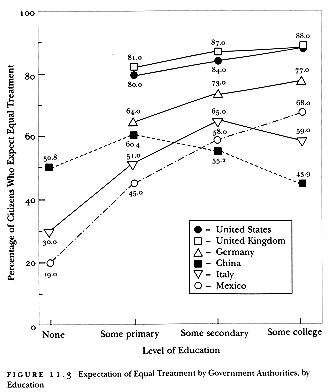
expectation of equal government treatment increases with the level of education. In the United States, Britain, and Germany, although education has a positive impact on people's expectation of fair government, the less educated do not expect to be treated categorically differently from the more educated. 32 In Italy and Mexico, the overall percentage of those expecting equal treatment is lower, and the differences between the more educated and the less educated are more marked. In Mexico, only 19 percent of the people with no education expect equal treatment compared to 68 percent of those with a university education: a spread of 49 points. In all six countries, except China and Italy, the expectation of equal treatment increases linearly with every step in the educational ladder.
In China and Italy, the relationship between education and output affect is curvilinear. The expectation of equal treatment increases with respondents' educational levels up to a certain point and then reverses itself. In Italy, in 1959, 30 percent of the most disadvantaged group expected equal treatment by the authorities. The expectation increased with each increase in education up to the level of secondary school. But the expectation of equal treatment among the most advantaged group, people with some college education, was 6 percent less than among those with secondary school education.
The shape of the curve in China is remarkable. Slightly more than half of the most disadvantaged group expect equal treatment by the government, a figure much higher than that of Italy and Mexico. The figure increases slightly with the level of education, but only up to the primary school level. Beyond this level, the advantage imparted by education not only disappears but becomes negative. Those with some secondary education are 5 percent less likely than those with some primary education to expect equal treatment, and those with some university education are nearly 17 percent less likely to hold this expectation.
In short, while the least-educated Chinese have the strongest output affect among the nations studied, the best-educated Chinese have the weakest. The decline associated with education is so sharp that Chinese with college educations are 6 percent less likely than their most educationally disadvantaged countrymen to expect equal treatment. Compared to college graduates in other countries, Chinese college graduates are more than 44 percent less likely to expect equal treatment than Americans and Britons, 33.1 percent less likely than Germans, 24.1 percent less likely than Mexicans, and 15.1 percent less likely than Italians.
When a person feels he cannot achieve his goals through conventional participation, one logical choice is to turn to unconventional political activities--either to oppose the political system, take advantage of its loopholes, or simply to express frustration and dissatisfaction. Findings from a 1988 survey in Beijing showed that political activities of these types are indeed associated with college education in China. 33 Our findings on output affect help to explain why.
The findings also show how a cultural attitude considered conducive to democracy may also help buttress authoritarianism. The relatively high Chinese figures on output affect dovetail with findings from the 1988 Beijing survey that many Chinese citizens have developed a range of techniques for exerting influence on the bureaucracy despite the authoritarian nature of China's political system. 34 This sense among ordinary people of having access to the system may help explain why political dissatisfaction among intellectuals has not struck many sparks among the broader population, especially in rural areas where the less-educated are concentrated. Together with the widespread ignorance of the government's impact noted above, the reservoir of confidence in the government among less-educated Chinese may have helped the authoritarian regime to survive. But the implications of the high system affect are not necessarily adverse to democracy. It might also help to stabilize the society during a transition to a more open system and give a new democratic system a grace period to establish itself.
Political Tolerance
Political tolerance is associated with two principles underlying the democratic process: the commitment to the equality of citizens and the protection of minority rights. Both require tolerance for the viewpoints and political activities of one's opponents. Some students of democracy consider tolerance the essential ingredient of democratic politics. As pointed out by Gibson and Duch, "without tolerance, widespread contestation is impossible, regime legitimacy is imperiled, and a numbing conformity prevails." 35
Interpretive studies have portrayed Chinese political culture as intolerant. According to Lucian Pye, for example, "the dominant emotion of modern Chinese politics has been a preoccupation with hatred coupled with an enthusiasm for singling out enemies." Pye states that Chinese political culture knows no equals, only superiors and inferiors, and that the Chinese perceive a sharp divide between friend and foe. 36 Using the survey technique, we can compare Chinese levels of intolerance to those elsewhere, compare intolerance in different domains (speaking, teaching, and publishing), and determine which sectors of the Chinese population are more or less intolerant.
Since The Civic Culture contains no measure for tolerance, we selected a series of items from the ISSP for comparison. The position presented in the 1985 ISSP survey was, "There are some people whose views are considered extreme by the majority. Consider people who want to overthrow the government by revolution." 37 The respondent was then asked whether he or she thought that such people should be allowed to express their views in a public meeting, express their views as a teacher in a college, and express their views by publishing articles or books. We adapted the question to the Chinese setting by stating, "There are some people

whose ideology is problematic, for example, they sympathize with the Gang of Four." 38 We then asked the same three questions.
Figure 11.4 presents the figures for China and for the six highly developed democratic ISSP countries. It reveals that the Chinese are indeed the least tolerant among the seven nations. Fewer than 20 percent of the Chinese respondents were willing to allow sympathizers of a deviant viewpoint to express their views in a meeting, as compared to 40 to 75 percent of the populations in the other countries. When asked about teaching, Chinese tolerance levels were even lower, standing at 10.3 percent of the population, but the gap between China and the other countries was not as large. Tolerance for publishing unpopular ideas was again low in China (10.3 percent), with the range in the other countries extending from 51.8 percent to 70.3 percent. 39
Political tolerance is normally associated with education: the less educated are less tolerant and more authoritarian. 40 Are the lower levels of tolerance in China attributable to generally lower levels of education, or does the tolerance gap remain when educational subgroups are compared across nations? Figure 11.5 breaks down tolerance for speaking at a meeting, by level of education. As in other countries, in China education has a strong positive impact on tolerance. But at each level of educational attainment, Chinese respondents are less tolerant than people in other countries.
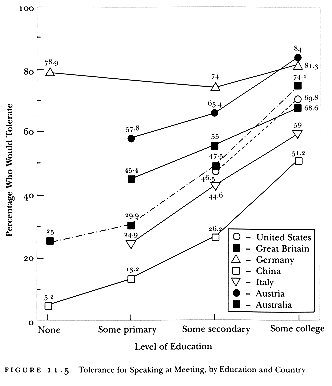
By far the most intolerant group in all the countries studied were the Chinese illiterates. 41 Figure 11.6 provides a profile of this group. It shows that illiterates are heavily concentrated among persons above age forty (that is, who were born in 1950 or before), and that within this group illiteracy is especially widespread among females resident in rural areas.
Figure 11.6 demonstrates how survey research can allow us to look some distance into the past. The curves give insight into the distribution of educational opportunities in China from 1920 to 1972. They confirm that most urban male children and many rural male children were given some education in the early Republican period, show that virtually no education was given to rural females until about 1930, and suggest that a fraction of urban females were given some education starting about
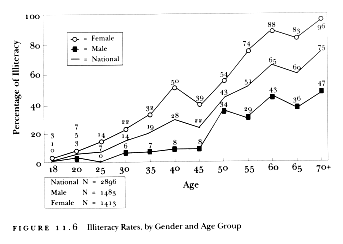
1920. 42 A number of refinements of this analysis are possible, but these rough figures are sufficient to illustrate the retrospective use of survey data. 43
The data suggest that average tolerance levels in China are likely to increase as older illiterates are replaced by later-born, better educated citizens. 44 Even so, Figure 11.5 shows that even the better-educated in China are less tolerant than their opposite numbers in the other countries studied. Tolerance levels in China may remain lower than those in democratic countries for some time, even with changes in the educational makeup of the population.
Prospects for Democracy
We have presented data on only three sets of attitudes out of many that are theoretically related to democracy. Political scientists have established no minimum thresholds for perceived saliency of government, internal and external efficacy, and tolerance in democratic societies. And political culture is but one of the several sets of conditions that affect the prospects for democracy. So our data justify no sweeping conclusions.
Some patterns in the data suggest potential difficulties if the Chinese political system begins to democratize. Relatively low levels of awareness of government's impact, system affect, and tolerance may pose impediments to democratization. People may be unmotivated to engage in politics and may favor the repression of ideas that they do not agree with. It is not clear whether the educated elite have sufficiently high levels of political tolerance to set an example for the rest of the population. Although educated Chinese are more likely to be aware of the impact of government, to feel able to understand and influence government, and to tolerate political speech by disliked groups, they are substantially less likely to hold democratic orientations than people of the same educational levels elsewhere.
The distribution of output affect in relation to other variables gives cause for both concern and hope. Although educated people are most likely to be aware of the influence of government and are more confident of their ability to understand and engage in politics, they are least likely to expect fair treatment from the government. They know that government policy can have a great effect on their lives, but they do not expect government officials to treat them equally. This contradiction may create psychological tension akin to what Ted Gurr calls "status reversal," an attitude Gurr considers conducive to outbreaks of rebellion. 45 If so, it helps to explain why this group has been the most likely to engage in regime challenging activities and why they may do so again.
The cultural profile of the rest of the population is virtually the reverse. They have a relatively low sense of the government's impact, relatively low internal efficacy, and relatively high system affect. In short, they are somewhat insulated from and satisfied with the government. The contrast between the two patterns suggests that if a political crisis between the regime and the intellectuals occurs again, the majority of the population may once again not offer much backing for the demands for democratic change. But if this is true, the implications for a democratic outcome are uncertain. The attitudinal gap between the educated and the uneducated that now helps to stabilize the regime may moderate the violence of a regime transition and provide a reserve of deference to help an infant democracy survive.
Nothing in our data supports the theory that Chinese political culture is an absolute bar to democracy. When compared to residents of some of the most stable, long-established democracies in the world, the Chinese population scored lower on the variables we looked at, but not so low as to justify the conclusion that democracy is out of reach. In general, as theory predicts, the more urban and educated sectors showed more democratic attitudes, supporting expectations derived from modernization theory that China's culture will move closer to the patterns characteristic of democratic countries as the economy grows. Once in place, a democratic regime could speed the pace of cultural change by actively inculcating the popular attitudes it needs to survive.
Conclusion: Cultural Distinctiveness and Universal Attributes
Because this chapter is concerned with questions of cultural distinctiveness and universalism, we have selected for analysis a few attributes for which comparative data are available. In each case, the distribution of attitudes in China both resembles and differs from the distributions in other countries. The data show China's culture to be distinctive, but only distributionally, not categorically. The attributes are universal, only the distributions are particular.
This finding, however, is in a sense an artifact of our approach. The survey method inevitably illuminates how Chinese citizens stand, compared to citizens of other countries, along universal or potentially universalizable dimensions of analysis, as well as how Chinese vary among themselves. In contrast to the interpretive method employed by most other research on Chinese political culture, survey results can never take the form of generalizations about all Chinese and how they differ from all non-Chinese. Surveys measure attributes which exist (whether they have been measured or not) in some degree everywhere, and they assess variation in the distribution of these attributes within and across one or more populations.
Of course, it is possible to ask a survey question that makes sense in only one culture, thus demonstrating the uniqueness of the culture. But this uniqueness would be an artifact of the way the question was asked and in that sense trivial. What is universal about a given norm or attitude is that which can be expressed in universal language (i.e., translated from language to language in a form that is understood within each language); what is distinctive about it is that which is expressed in a way that is understood in only one language. The norm or practice itself is intrinsically neither universal nor particular. An attitude can be shifted from the category of the unique to that of the universal, either linguistically or by going up or down the ladder of abstraction. Guanxi , for example, is culturally unique, but particularism (of which guanxi is an example) is universal.
By the same token, findings of cultural distinctiveness are equally an artifact of the interpretive approach. In this approach, cultural attributes are conceptualized with such specificity or complexity that what is portrayed is by definition unique. Ambrose King's informative discussion of guanxi and network building in an earlier issue of Daedalus provides an example. 46 If we were to ask Americans whether they function through guanxi , they would say no, because they would not know what we were talking about. If we were to ask them whether they sometimes get things done through networks or connections, or whether they consider it proper to help a relative or friend under certain circumstances, or whether it is important to cultivate personal relations with people from whom one wishes to get favors, many of them would say yes, perhaps as many in the United States as in China.
If King is describing something distinctively Chinese, it is not because the component cultural attributes are distinctive to China, but because the author has formulated a complex of attitudes and behaviors which is unique as a whole and by definition. Such a claim of uniqueness is not accessible to proof by survey research, because the survey technique of measurement requires the breakup of a cultural complex into measurable components. Since such components are cross-culturally measurable, they are bound to some degree to be cross-culturally existent. Cultures, then, are unique synthetically, universal analytically. Both the distinctiveness and nondistinctiveness of cultures are not facts about cultures, but artifacts of the ways in which cultures are studied.
Note *: The authors acknowledge the support of National Science Foundation grant INT-88-14199, a grant from the United Daily News Cultural Foundation, and the assistance of the Opinion Research Center of China, Social and Economic Research Institute of Beijing, under directors Chen Ziming and Wang Juntao. Back.
Note 1: See, for example, Lucian W. Pye with Mary W. Pye, Asian Power and Politics: The Cultural Dimensions of Authority (Cambridge: Harvard University Press, 1985); Lucian W. Pye, The Mandarin and the Cadre: China's Political Cultures (Ann Arbor: Center for Chinese Studies, 1988); Andrew J. Nathan, Chinese Democracy (New York: Knopf, 1985); and various articles in "The Living Tree: The Changing Meaning of Being Chinese Today," Daedalus 120:2 (Spring 1991). Back.
Note 2: Pye, Mandarin and Cadre , p. 8, uses this term. Back.
Note 3: Well-known examples of this kind of work dealing with China, besides those cited above, include Lucian W. Pye, The Spirit of Chinese Politics (Cambridge: MIT Press, 1967); Benjamin I. Schwartz, China's Cultural Values (Tempe, AZ: Center of Asian Studies, 1985); and Richard H. Solomon, Mao's Revolution and the Chinese Political Culture (Berkeley: University of California Press, 1971). Back.
Note 4: Outstanding examples of the use of this approach include Gabriel A. Almond and Sidney Verba, The Civic Culture (Princeton: Princeton University Press, 1963; abr. ed., Boston: Little, Brown, 1965; abr. ed. reprint, Newbury Park, Calif.: Sage Publications, 1989); Alex Inkeles and David H. Smith, Becoming Modern: Individual Change in Six Developing Countries (Cambridge: Harvard University Press, 1974); Samuel H. Barnes et al., Political Action: Mass Participation in Five Western Democracies (Beverly Hills, CA: Sage Publications, 1979); Ronald Inglehart, Culture Shift in Advanced Industrial Societies (Princeton: Princeton University Press, 1990); and Scott C. Flanagan et al., The Japanese Voter (New Haven: Yale University Press, 1991). Back.
Note 5: Gabriel A. Almond, "The Study of Political Culture," in A Discipline Divided (Newbury Park, CA: Sage Publications, 1990), p. 42. Back.
Note 6: According to Ibid., 143-44, political culture consists of the set of subjective orientations to politics in a national population or subset of a national population; has cognitive, affective, and evaluative components; is the result of childhood socialization, education, media exposure, and adult political experiences; and reflects and affects political and governmental structure and performance. Back.
Note 7: A possible exception is a survey conducted by the State Statistical Bureau for Ronald Inglehart on materialism and postmaterialism. At the time of writing this paper, we do not know the details of this study. Statistical induction is the process of generalizing from the characteristics of a sample to the characteristics of the population from which it was selected. Back.
Note 8: See, for example, Paul J. Hiniker, Revolutionary Ideology and Chinese Reality: Dissonance Under Mao (Beverly Hills, CA: Sage Publications, 1977); Solomon, Mao's Revolution ; Susan L. Shirk, Competitive Comrades: Career Incentives and Student Strategies in China (Berkeley: University of California Press, 1982); Nathan, Chinese Democracy; William L. Parish and Martin King Whyte, Village and Family in Contemporary China (Chicago: University of Chicago Press, 1978); and Martin King Whyte and William L. Parish, Urban Life in Contemporary China (Chicago: University of Chicago Press, 1984). Back.
Note 9: Dong Li, "Public Opinion Polls and Political Attitudes in China, 1979-89," (Ph.D. diss., Columbia University, 1993). Back.
Note 10: Min Qi, Zhongguo zhengzhi wenhua (Kunming: Yunnan renmin chubanshe, 1989). By national, we mean covering the entire Chinese mainland with the possible exception of certain remote and lightly populated areas. Back.
Note 11: Previous large-scale studies of mass behavior in communist societies were based on surveys of emigrants. The largest were reported in Alex Inkeles and Raymond A. Bauer, The Soviet Citizen (Cambridge: Harvard University Press, 1959) and James R. Millar, ed., Politics, Work, and Daily Life in the USSR: A Survey of Former Soviet Citizens (New York: Cambridge University Press, 1987). Since the fall of communism, the survey enterprise has accelerated in the postcommunist societies, but national level surveys remain rare. We are aware of surveys in progress by Arthur H. Miller (Russia, Ukraine, and Lithuania); James Gibson (Russia); Samuel Barnes and Peter McDonough (Eastern Europe); and Sidney Verba, Cynthia S. Kaplan, and Henry E. Brady (Russia and Estonia). Back.
Note 12: The ISSP is a continuing program of cross-national collaboration conducted in Australia, Germany, the United States, Great Britain, Austria, and Italy. It brings together preexisting national social science projects and coordinates research goals by adding a cross-national perspective to the individual national studies. See International Social Survey Programme, Role of Government--1985 Codebook ZA-NO. 1490 (Ann Arbor: ICPSR, University of Michigan). Back.
Note 13: We define democracy as a system of authentically competitive elections for national and local offices. Authentic competition requires freedom of political organization, freedom of political speech, the right of citizens to run for office, and the secret ballot. Back.
Note 14: Almond and Verba, Civic Culture ; J. Roland Pennock, Democratic Political Theory (Princeton: Princeton University Press, 1979), pp. 36-59; and Robert A. Dahl, A Preface to Democratic Theory (Chicago: The University of Chicago Press, 1956). Some works stress cultural prerequisites for democratization; some stress cultural requisites for the stability of democratic systems. Although the two arguments are logically distinct, the attributes cited are generally the same. Back.
Note 15: James L. Gibson and Raymond M. Duch, "Emerging Democratic Values in Soviet Political Culture," in Arthur H. Miller, William M. Reisinger, and Vicki L. Hesli, eds., Public Opinion and Regime Change: The New Politics of Post-Soviet Societies (Boulder, CO: Westview, 1993), p. 1. Back.
Note 16: Almond and Verba, Civic Culture , pp. 9-88; abr. ed., pp. 6-52. Of course, the term "local government" refers to different objects in different countries; this partially explains different levels of awareness in different countries. In China, for example, people may think it is the "party" or "cadres" and not the "government" that affects their lives locally. But if one anticipates this and asks a different question in each country, the results cannot be considered comparable. Generally, the most equivalent stimulus is the one that uses the most similar language. After getting an initial measure of differences across countries based on an equivalent stimulus, one can ask additional questions to explore hypotheses that one thinks may explain cross-national differences. Back.
Note 17: Revisionist views have been presented by Vivienne Shue, The Reach of the State (Stanford: Stanford University Press, 1988), and Victor Nee, David Stark, and Mark Selden, eds., Remaking the Economic Institutions of Socialism: China and Eastern Europe (Stanford: Stanford University Press, 1989), among others. Back.
Note 18: Parish and Whyte, Village and Family in Contemporary China ; Whyte and Parish, Urban Life in Contemporary China ; and Jean C. Oi, State and Peasant in Contemporary China: The Political Economy of Village Government (Berkeley: University of California Press, 1989). Back.
Note 19: Samuel P. Huntington and Joan M. Nelson, No Easy Choice (Cambridge: Harvard University Press, 1976), pp. 3-45. Back.
Note 20: We distinguish rural and urban sectors by the respondent's type of household registration. The actual place of residence at the time of the survey may be different, but the household registration establishes an individual's legal permanent residence, and usually corresponds to the actual place of residence. Back.
Note 21: Almond and Verba, Civic Culture , p. 6; abr. ed., p. 2. Back.
Note 22: These figures accord closely with those for the population as a whole derived from census data, testifying to the accuracy of our sample. Back.
Note 23: Almond and Verba, Civic Culture , pp. 7-19; abr. ed., pp. 6-17. Back.
Note 24: See among others, Norman H. Nie, G. Bingham Powell, Jr., and Kenneth Prewitt, "Social Structure and Political Participation: Developmental Relationships," Parts I and II, American Political Science Review 63:2 (1961), pp. 361-78; and 63 (3) (1961), pp. 808-32; Lester Milbrath and M. L. Goel, Political Participation: How and Why Do People Get Involved in Politics? , 2d ed. (Chicago: Rand McNally, 1977), pp. 58-59; Russell J. Dalton, Citizen Politics in Western Democracies (Chatham, N.J.: Chatham House Publishers, 1988), p. 50; and M. Stephen Weatherford, "Measuring Political Legitimacy," American Political Science Review 86:1 (March 1992), pp. 149-66. Back.
Note 25: Angus Campbell, Gerald Gurin, and Warren E. Miller, The Voter Decides (Evanston, IL: Row, Peterson, 1954), p. 187. Back.
Note 26: Almond and Verba, Civic Culture , p. 14; abr. ed., pp. 168-69. Back.
Note 27: Campbell, Gurin, and Miller, The Voter Decides . Back.
Note 28: Stephen C. Craig, Richard G. Niemi, and Glenn E. Silver, "Political Efficacy and Trust: A Report on the NES Pilot Study Items," Political Behavior 12:3 (September 1990), p. 290. Back.
Note 29: To avoid response set, some questions are asked in a positive form, some in a negative form; for national-level political understanding, a "disagree" answer indicates efficacy. Back.
Note 30: For example, "People like me don't have any say about what the government does." Back.
Note 31: Milbrath and Goel, Political Participation , chap. 3 and 4. Back.
Note 32: Almond and Verba, Civic Culture , pp. 110-11; abr. ed., pp. 73-74. Back.
Note 33: They are explored in Tianjian Shi, "Political Participation in Beijing: a Survey Study," Ph.D. diss., Columbia University, 1992; published as Political Participation in Beijing (Cambridge: Harvard University Press, 1997). Back.
Note 35: See among others, Larry Diamond, Juan Linz, and Seymour Martin Lipset, eds., Democracy in Developing Countries: Asia , vol. 3 (Boulder, CO: Lynne Rienner, 1989), pp. 16-17; James L. Gibson, "The Political Consequences of Intolerance: Cultural Conformity and Political Freedom," American Political Science Review 86:2 (June 1992), pp. 338-56; and Gibson and Duch, "Emerging Democratic Values," p. 72. Back.
Note 36: Lucian W. Pye, The Spirit of Chinese Politics , new ed. (Cambridge: Harvard University Press, 1992), pp. 67-84. Back.
Note 37: International Social Survey Programme, Role of Government--1985 Codebook . Back.
Note 38: The Gang of Four is a very different stimulus from revolution, but we would have endangered our project if we had raised the question of overthrowing the government in China. The Gang of Four was the most equivalent feasible stimulus we could think of. Many of the population attribute their suffering during the Cultural Revolution to the Gang of Four. In the early 1980s, the regime carried out a purge of alleged sympathizers of the Gang, expelling many from the Party and giving prison terms to some. Back.
Note 39: These figures are net of "don't know" answers, which constituted 18.0 percent on speaking, 20.9 percent on teaching, and 21.2 percent on publishing. The high "don't know" percentages indicate that for many respondents the question was too controversial to answer. Back.
Note 40: Seymour Martin Lipset, Political Man , exp. and updated ed. (Baltimore: Johns Hopkins University Press, 1981), chap. 4; and Gibson, "Political Consequences," p. 346. Back.
Note 41: This is with the exception of the two cases from the American sample who had no formal education and were intolerant. We deleted them from the display because their tiny number makes the association between education and intolerance in their case statistically insignificant. Back.
Note 42: These findings are consistent with those of Evelyn Sakakida Rawski, Education and Popular Literacy in Ch'ing China (Ann Arbor: The University of Michigan Press, 1979). Back.
Note 43: We could recalculate the figures in terms of urban and rural places of birth instead of urban and rural places of current household registration, and correct for disproportionate deaths above the national average in each population segment in order to recover the population makeup of earlier time periods. Back.
Note 44: Our data show that tolerance levels in China decrease sharply with age. Back.
Note 45: Ted Robert Gurr, Why Men Rebel (Princeton: Princeton University Press, 1970). Back.
Note 46: Ambrose Yeo-chi King, "Guanxi and Network Building: A Sociological Interpretation," Daedalus 120:2 (Spring 1991), pp. 63-84. Back.